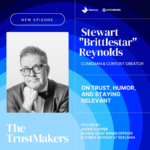By Kate Watts, CEO, 50,000feet
The “AI-first” mindset emerged from Silicon Valley as a rallying cry: look first to AI to solve every business problem before considering any other option, including finding people to help. Lately, AI-first has regained currency because some high-profile tech executives have urged their companies to go all-in with AI. But like all early-stage narratives—think “digital-first,” “mobile-first” or “cloud-first”— its power will fade as the technology becomes ubiquitous.
Especially for large businesses, the AI-first mindset feels out of step with the reality of how they are weaving AI into their already-established operations. They’re growth-first organizations that see AI as an element — albeit an important one — of their technology stack, supporting people who have agency to solve business problems. They’re not forcing AI into the mix just because they can. They’re using it where it matters most: to enable people, improve customer experiences, and strengthen brand relevance in a volatile world.
From Rallying Cry to Operating System
AI-first thinking made sense in the early going. Startups needed an efficient way to scale. Early adopters needed a differentiator. But AI is increasingly being integrated into the operations of businesses and daily habits of consumers. Most of the time, people don’t need to know if a recommendation engine is powered by machine learning or whether a chatbot is built on GPT. The tech matters, but the experience matters more. The winners in today’s AI landscape are the companies that treat AI not as a headline, but as plumbing—deeply embedded, quietly running, always on.
Netflix is an instructive example of a business integrating technology rather than being led by it. The company was born at the dawn of the digital age, and its ability to embrace digital and AI is essential to understanding its growth trajectory. But Netflix did not become a powerhouse by becoming “AI first” or “digital first.” Netflix was and remains a modern entertainment business whether hosting someone else’s content or creating its own. But to support its business, Netflix happens to use digital and AI exceptionally well to recommend, personalize, localize, and scale. AI is not the north star for solving its business problems.
AI as a Business Enabler, Not a Mandate
The trouble with the AI-first label is that it often prioritizes the technology over the outcome. It encourages companies to ask, “How can we use AI?” instead of, “What’s the smartest way to solve this problem?”
This mindset can lead to disconnected deployments and put pressure on employees to use AI tools regardless of whether they improve workflows. In some companies, AI is starting to feel like a mandate, not a mindset, and a replacement, not an enhancement. (And who can blame them when they read about businesses that overtly embrace the binary notion of automation over humanity?)
Growth-first AI is a more grounded approach. It starts with the core mission: How do we serve customers better? How do we empower employees to do their best work? How do we make our brand more adaptable, more human, more relevant? From there, AI becomes the tool, not the story. And this is true even of newer forms of AI such as generative AI. Even though generative AI has been in the mainstream for only a few years, larger businesses are resisting the temptation to treat it like a shiny object. They’re carefully and thoughtfully using it to support operations.
For example, BMW Group uses generative AI to support its 450 DevOps teams by providing real-time insights, code suggestions, and infrastructure recommendations. Why? Not because generative AI is the end-all and be-all. It’s because the company saw generative AI as an opportunity to enhance human decision-making and operational efficiency.
Johnson & Johnson is a telling example. When generative AI first exploded in popularity, the company set up an AI governance board to encourage employees to experiment with generative AI. From that initial effort, the company identified a handful of viable use cases. J&J then disbanded its governance board (whose existence arguably reflected an AI-first approach) and is embedding generative AI at the business unit level where it can add the most value to grow the business by solving problems like improving supply chain management and drug discovery
Better Brand Craftsmanship
Growth-first AI doesn’t mean playing it safe with brand building. It means applying AI with intention. It’s not about brute-force automation or replacing every function with a bot. It’s about crafting AI experiences that reflect your brand’s voice, values, and promise.
Some of the most exciting work happening in AI right now is also the most human. Think of AI as a new kind of creative assistant; one that helps you explore, simulate, localize, and adapt at a scale we’ve never seen before. But like any tool, it requires craftsmanship. If you want AI to make your brand stronger, it must be integrated into your creative operating system.
And there is no shortage of businesses doing this. Newell Brands, the parent company of Sharpie, Rubbermaid, and Yankee Candle, has integrated generative AI into its marketing processes to develop consumer personas for market research, analyze insights, and accelerate innovation. This approach supports their teams by providing deeper customer understanding and speeding up the development of marketing strategies. Optus, an Australian telecommunications company, uses generative AI to improve marketing mix modeling. With AI, the company can analyze complex data sets to better understand the impact of various marketing channels, leading to more informed decision-making and efficient budget allocation.
The Creative Path Forward
A growth-first approach also means that the creative teams at the center of building timeless brands act as artisans, treating AI as a tool rather than the focus of the brand. When brands shift the focus of their narrative to AI instead of the outcome, they assume an AI-first mentality, which is distracting and inevitably dated – the opposite of what a timeless brand should be doing.
Creatives have always been more than content producers. They are designers of brand meaning, translators of cultural signals, and guardians of emotional resonance. With a business-first mindset, those responsibilities grow more interesting because AI enriches the creative toolkit. The question should not be “How can AI help make our story more powerful?” because AI should be assumed to be part of the solution.
The risk of letting AI become the focal point of a campaign is clear. Consider Volvo’s recent “Come Back Stronger” campaign, which leaned heavily into the AI-driven nature of its production. Instead of celebrating the campaign’s powerful themes of resilience and cultural progress, much of the public discussion centered on how the ad was made, not what it was trying to say. The use of AI became the headline, overshadowing the emotional core of the work.
With a growth-first mindset, the real test of a timeless brand is whether it can evolve with culture without ever letting the tools define it.
We are no longer at the beginning of the AI journey. We are in the development phase. AI is being integrated into the foundation of every modern business, improving how work gets done and value gets created.











